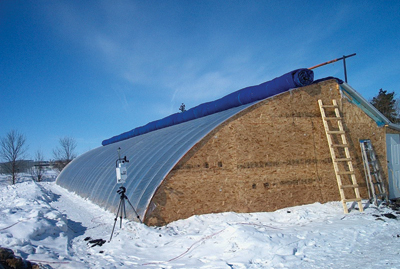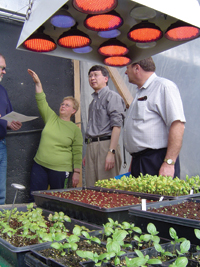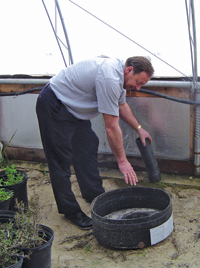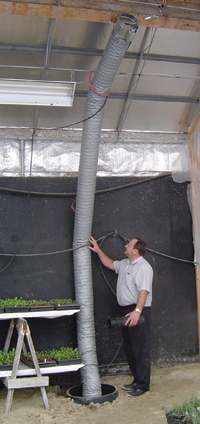
Over the past year, researchers from the University of Manitoba have
completed a fourth round of tests in ongoing efforts to reduce heating
costs, extend the growing season and improve the overall effectiveness
of solar greenhouse operations in cold climates.
Manitoba research is fine-tuning such greenhouses for cold climates
 |
|
| The University of Manitoba solar greenhouse is 22 by 100 feet. photos courtesy manitoba hydro Advertisement
|
Over the past year, researchers from the University of Manitoba have completed a fourth round of tests in ongoing efforts to reduce heating costs, extend the growing season and improve the overall effectiveness of solar greenhouse operations in cold climates.
The findings are also setting the stage for testing solar greenhouses in northern communities where cost savings and a longer growing season could pay off in socio-economic and health benefits for people in such communities.
The research was conducted at Blue Lagoon Florascape, a solar energy greenhouse near St. Francois Xavier, which is just west of Winnipeg. The greenhouse, originally built by Dr. Chong Zhang, a professor of Biosystems Engineering at the University of Manitoba, is based on a Chinese design. It measures 22 feet wide, 100 feet long, and is about 13 feet high. A wall of concrete, eight inches thick and just over seven feet high, runs the length of the greenhouse to form the north wall. The concrete stores solar energy during the day for release at night to keep plants warm.
 |
|
| LEDs in study | |
 |
|
| Buried ductwork converges at this plastic drum, one of two in the system for releasing warm exhaust air at night. | |
 |
|
| Channels were dug for the network of plastic ducts used with the earth charger system. | |
 |
|
| The intake for hot air from the upper levels of the greenhouse, connected to the earth charger system.
|
SEVERAL NEW TECHNOLOGIES INVOLVED IN RECENT TESTS
■ The most recent tests, notes Manitoba Hydro engineer Ray Borys, looked at a novel plant growth lighting system for extending the growing season during the winter months, a new type of plastic covering for the greenhouse, and an “earth charger” system that, much like the solar wall, is designed to store solar energy during the day for release at night.
Basil and cucumber plants were grown in the greenhouse and monitored under a cluster of light-emitting diodes (LEDs), under a conventional high-pressure sodium (HPS) grow light, and with no supplementary light source. Plant performance was compared to determine the effect of the lighting systems.
Generallly speaking, “greenhouse plants grow best when they receive 16 hours of light, followed by eight hours of darkness each day,” Borys says. “In Manitoba’s winter, however, this is not possible through sunlight alone.”
The supplemental lighting systems were controlled by a timer to power on at sunset and remain on long enough for the plants to receive a combined light exposure of 16 hours.
Underneath the plants were 130-watt heat mats. These inch-thick mats, two feet by four feet in size, are a type of electric heating blanket that warms the plants’ root zones.
ROOTZONE HEATING FOUND TO BE EXTREMELY EFFECTIVE
■ Earlier research, Borys says, has shown that rootzone heating permits growers to lower ambient temperatures in the greenhouse by up to 10ºC without affecting plant performance.
The LED lighting system consists of a 22.5 x 22.5 x 5.5-inch metal fixture, with five blue LED bulbs (each with 60 diodes), interspersed between eight red LED bulbs (each with 180 diodes). On average, the LED bulbs last more than 50,000 hours. The system is recommended for lighting nine to 16 square feet of space.
The high-pressure sodium (HPS) lighting system consists of a large HPS bulb, reflective shade, ballast and the necessary hardware. “It can illuminate a table area of 16 to 36 square feet,” Borys says. The bulb comes with a one-year warranty, and an average lifespan of 8,760 hours.
A comparison of plant height, leaf span, and stalk height was performed for the basil and cucumber trials. Borys reports that 28 days after germination, the basil under the LED lamp was 33.3 per cent taller than basil grown without a supplementary light source. Results for the basil growing under the HPS lamp were inconclusive.
‘Holland’ and ‘Carmen’ cucumber varieties were used in the second trial.
Fourteen days after germination, the ‘Holland’ variety, under the LED and HPS lamps, had average leaf spans 45.8 per cent and 44.4 per cent larger, as well as plant height 41.1 per cent and 7.5 per cent greater, than those grown without any supplementary light source.
The ‘Carmen’ variety, grown under the LED and HPS lamps, had average leaf spans 54.7 per cent and 37.5 per cent larger, as well as plant heights 57.7 per cent and 14.1 per cent greater, than those grown without any supplementary light source.
Visually, it was apparent that the plants under the LED system performed the best, as they were taller, fuller and lusher.
“The findings suggest that LED lighting promotes plant growth and health better than conventional HPS lighting, at about one-tenth the cost in electricity,” Borys notes. “However, the LED lighting cluster cost roughly four times as much as the HPS lighting.”
NEW COVERING MATERIAL TRAPS MORE HEAT AT NIGHT
■ The greenhouse was covered using the conventional approach of air inflated double polyethylene. The difference was in the poly itself, which was of a special type designed to retain heat in the greenhouse by reducing long wave radiation from the greenhouse at night.
According to the manufacturer’s specs, the 8-mil poly used to cover the greenhouse allows 89 per cent of sunlight to enter the greenhouse during the day, and blocks 85 per cent of the heat radiated by the plants and earth from escaping at night.
The cost of covering the greenhouse with 8-mil poly, including shipping costs, was $650 ($1.77/square metre), compared with $1.45/square metre for conventional 6-mil poly.
Where solar radiation and outdoor temperatures are similar, it can be expected that the 8-mil poly will maintain a slightly warmer indoor temperature than conventional 6-mil poly.
An earth charger system, Borys notes, is an inexpensive subsoil heat storage system designed to test whether air drawn from near the peak during the day could warm the soil sufficiently to help keep the greenhouse warm at night. The system works much like the solar wall to keep temperatures warmer overnight.
Four 55-gallon barrels were buried in the earthen floor of the third section of the greenhouse, two along each of the north and south edges. Thirty pieces of perforated, four-inch, flex tubing extended from the north barrels to the south barrels, installed in 10 trenches. In each trench, the tubing was buried at three-foot, two-foot and one-foot depths below the soil surface. The barrels at the north edge of the section were connected by ductwork to ceiling fans.
EARTH CHARGER SYSTEM INSTALLED TOO LATE IN TRIAL
■ During the day, warm air from the top of the structure was drawn through the buried tubes, losing heat energy to the surrounding soil as it was moved along. The air was then expelled as cooler air from the south barrels.
During the night, the cool air drawn in by the fans picked up heat energy from the soil and was expelled as warmer air into the greenhouse.
Preliminary research on a similar system at a greenhouse in North Carolina showed that 20 per cent of incoming solar energy was captured by the earth charger during the day. Two-thirds of the solar energy captured was released to the greenhouse at night. The remaining one-third remained in the soil, raising its temperature.
The warming effects of the earth charger system were minimal because the ductwork was installed toward the end of January, after the ground was frozen. “Because of the late installation,” he says, “the initial soil temperature was so low that, despite warm air bringing heat energy as it circulated through the pipes, the soil was not able to reach high enough temperatures to effectively heat the air at night. The earth charger system should also be tested for a full season.”
The cost of the earth charger system was about $550, not including installation, Borys notes. However, renting trenching equipment or hiring manual labour for the installation can be costly, and an electrician was needed to install the fans and rheostat, adding to the cost.
“Our results continue to support the feasibility of growing vegetables in solar greenhouses over the winter months in Manitoba,” Borys observes, “but point to the need for a source of supplementary heat to avoid losing a crop following a series of cold days with low solar radiation. An internal thermal blanket for cutting heat loss from the greenhouse at night is an important option for further Research.” ■
Myron Love is a freelance writer and photographer in Manitoba.
Print this page